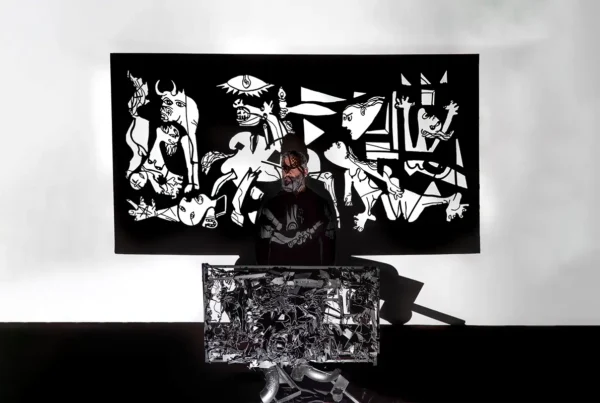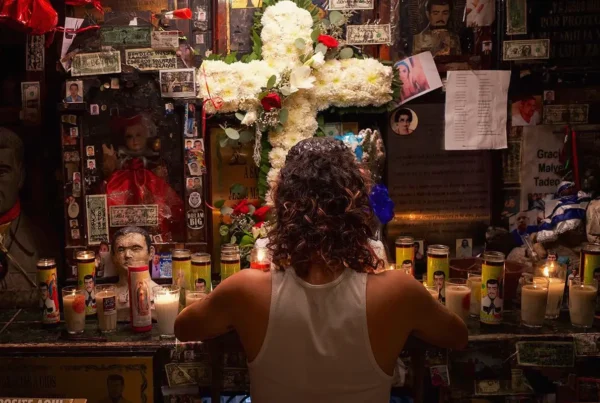“Berlin represented the change and freedom I needed, offering a wealth of possibilities for creation, with more accessible infrastructure and a vibrant, independent art scene like no other in Europe.”
Giordano Cioni: A Journey to Artistic Authenticity
For Giordano Cioni, the path to becoming an artist was not immediate or straightforward. Although his creative interests were always present, he initially pursued a career in London’s photography industry, working as a producer in photo agencies. Throughout his twenties, despite professional success, there was a persistent sense of dissatisfaction. Photography and film had long been hobbies of his, yet he hesitated to fully embrace them as a career. The idea that his creative pursuits could become a serious profession seemed out of reach, leaving him feeling incomplete.
It was the discovery of his queer community that catalyzed a profound shift in his life. Forming deep connections with artists allowed him to see the life he had always longed for. Surrounded by people who confidently followed their artistic passions, he found the inspiration and self-assurance he needed to make a significant change. As he approached his thirties, he took the bold step of leaving behind his career and life in London, seeking to establish himself as an artist in Berlin. Berlin, with its independent art scene and rich creative infrastructure, represented the freedom and opportunity he craved, offering him the environment to fully explore his artistic practice.
This pivotal decision marked the true beginning of Cioni’s artistic career, where he found both the space and community to explore his potential. It was a move that not only redefined his career but also allowed him to fully engage with his creative passions, leading him toward a fulfilling and ever-evolving artistic journey.

Giordano Cioni: A Minimalist Exploration of Myths and Symbols
Cioni’s artistic style, which he describes as “minimalist with a soul,” revolves around simplicity that carries profound depth. His work seeks to distill visual elements to their core, allowing their symbolic meanings to emerge more powerfully. The restraint of minimalism in Cioni’s hands is not a removal of complexity but a thoughtful reduction, a process of paring down to the most potent essence. This approach invites viewers to engage with the underlying meanings and to look beyond the surface simplicity. His work consistently maintains a quiet intensity, a balance between form and emotion, encouraging reflection and contemplation.
The thematic core of Cioni’s work is deeply intertwined with Western mythology and esoteric traditions. His fascination with ancient myths, particularly those that explore the construction of the cosmos and archetypal forces, drives much of his creative exploration. Through his art, he aims to forge a connection between human consciousness and larger cosmic patterns, offering a visual representation of the metaphysical forces that shape both our inner worlds and the universe. This dialogue between the material and the metaphysical is central to his process, as he strives to make tangible the invisible energies that influence existence.
In pursuing these themes, Cioni’s work becomes a bridge between ancient narratives and contemporary expression. He draws on mythology not as a relic of the past, but as a living tradition that continues to inform modern consciousness. His minimalist approach allows these ancient symbols and stories to resonate in a fresh, potent way, making them relevant to today’s viewers while preserving their timeless significance.

Artistic Rituals and Influences in Giordano Cioni’s Creative Process
Rituals play an essential role in Cioni’s artistic practice, serving as the foundation of his creative focus. Whether in the research phase or during the creation of his photographs and sculptures, he places great emphasis on entering a meditative state where distractions are minimized, and a deeper connection to his work can emerge. To achieve this mental clarity, Cioni employs techniques like meditation and mindful breathing, both before starting and during his creative sessions. These practices help him to still his mind, allowing for an uninterrupted flow of creativity. Incense often accompanies these rituals, particularly during indoor shoots or when sculpting, as its presence sustains the concentration and energy necessary for his process.
The ability to remain fully present is crucial for Cioni’s productivity and artistic integrity. If his mind is unsettled, he finds the creative process inefficient and unfulfilling. On the other hand, when he is deeply immersed in his work, time seems to disappear, and the act of creation becomes effortless. This experience of losing track of time signals to him that he has reached a place of true creative engagement, where the work becomes more meaningful and reflective of his vision.
Cioni draws his artistic influences from a wide range of sources, from visual art to philosophy, psychology, and ancient wisdom. Artists like Georgia O’Keeffe, Hilma af Klint, and Alexandru Chira, known for their exploration of mystical themes, have significantly impacted his approach to spiritual and symbolic abstraction. Their ability to imbue abstract forms with deeper metaphysical meaning resonates strongly with Cioni’s own artistic goals. In sculpture, contemporary figures like Huma Bhabha and Marion Verboom inspire him with their innovative approaches to historical and mythical motifs. Additionally, Cioni is influenced by philosophical and esoteric thinkers such as René Schwaller de Lubicz, whose work further deepens his exploration of the intersection between art and spirituality.

Giordano Cioni: Pushing Boundaries Through Photography and Sculpture
One of Cioni’s most personal and significant works, Jökulsárlón, exemplifies his dedication to pushing beyond his comfort zone and merging his photography and sculptural practices. Created during a residency at Iceland’s Hafnarborg Museum, the work captures the serene beauty of the Jökulsárlón Glacier Lagoon, a site that resonated deeply with Cioni as he explored the myth of the Age of Aquarius. For him, the floating icebergs symbolized the Water-Bearer of the myth, and his photographic journey became a visual metaphor for this archetypal figure. Armed with a medium-format analog camera, Cioni ventured into the lagoon at dusk, encountering both the awe-inspiring landscape and the unsettling presence of curious seals.
The artistic process unfolded as Cioni lost himself in the act of photographing the frozen landscapes. As the sun set and darkness approached, an unexpected moment of beauty occurred: a full pink moon rose, illuminating the lagoon in a breathtaking scene that left a lasting impression on the artist. This spontaneous encounter with the moon became a symbol of reward for Cioni’s perseverance and commitment to his artistic evolution. The photograph was later framed with an engraved astrological glyph, further blending his interests in sculpture, photography, and mythology.
This piece holds a special place in Cioni’s career, marking a significant step in his artistic development and his growing desire to integrate different mediums. His experience with Jökulsárlón represents the culmination of his creative process—pushing boundaries, embracing new challenges, and finding inspiration in both the natural world and his internal exploration of myth and symbol.






